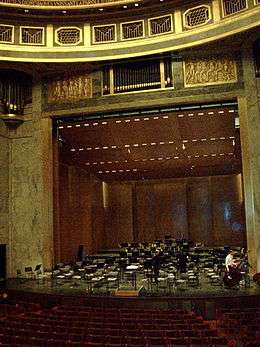Le bœuf sur le toit
| Le Bœuf sur le toit | |
|---|---|
|
Stage of the Théâtre des Champs-Élysées | |
| Choreographer | Jean Cocteau |
| Music | Darius Milhaud |
| Premiere |
February 1920 Théâtre des Champs-Élysées, Paris |
| Setting | Brazil |
| Genre | Surrealist ballet |
| Type | Classical ballet |
Le Bœuf sur le toit, Op. 58 (English title, The Ox on the Roof: The Nothing-Doing Bar) is a surrealist ballet made on a score composed by Darius Milhaud, which was in turn strongly influenced by Brazilian popular music. The title is that of an old Brazilian tango, one of close to 30 Brazilian tunes (choros) quoted in the composition. The piece was originally to have been the score of a silent Charlie Chaplin film (Cinéma-fantaisie for violin and piano).
Its transformation into a ballet (Pantomime Farce) was the making of the piece, with a scenario by Jean Cocteau, stage designs by Raoul Dufy, and costumes by Guy-Pierre Fauconnet. There is no real story to speak of, but a sequence of scenes based on music inspired by Brazil, a country in which the composer spent two years during World War I. The stage set is that of a bar frequented by a number of characters: a bookmaker, a dwarf, a boxer, a woman dressed in men's clothing, a policeman who is decapitated by the blades of an overhead fan before he is revived, and a number of others. The first actors were in fact clowns from the Medrano circus, the Fratellini. The choreography was deliberately very slow, in marked contrast to the lively and joyful spirit of the music.
The premiere was given in February 1920 at the Théâtre des Champs-Élysées and comprised, besides the ballet, Adieu New York by Georges Auric, Cocardes by Francis Poulenc and Trois petites pièces montées by Erik Satie.[1]
The version for chamber orchestra was followed by another for piano duet, subtitled Cinema Symphony on South American Airs (its performance lasts about a quarter of an hour).
The ballet gave its name to a celebrated Parisian cabaret-bar, Le Bœuf sur le toit, which opened in 1921 and became a meeting-place for Cocteau and his associates.
Analysis
The music for the piece cycles through keys in this manner: C, Cm, Eb, Ebm, Gb, F#m, A, G, Gm, Bb, Bbm, Db, C#m, E, D, Dm, F, Fm, Ab, Abm (later becoming G#m), B, A, Am and then finally in C again to close the work. The opening, and oft-repeated, rondo theme rises in tonality on each restatement initially by a minor third, but after each fourth appearance is reiterated a whole tone lower instead. It is stated twice in C major, at the very beginning and the very end, and interestingly also twice in A major separately in the middle of the work. Every minor key, except E minor, is modulated to, and the jaunty opening theme is restated in each of the twelve major keys in turn according to the key scheme enumerated above, piquantly satirizing in quintessential French manner certain didactic German teaching pieces that plod dryly and humorlessly through all twelve major keys, like the two such works for organ written as exercises for that instrument by the young Beethoven in his Bonn student days that contain absolutely nothing of the originality and expressive power of the great works of his maturity.
Instrumentation
The original scoring calls for a large chamber orchestra comprising 25 players:
- Two flutes, one doubling on piccolo;
- One oboe;
- Two B♭ clarinets;
- One bassoon;
- Two horns in F;
- Two trumpets in C;
- One trombone;
- One percussionist playing: guiro,[2] tambourine, bass drum and cymbals;
- Strings : violins 1 and 2, violas, cellos, double basses.
Other stagings
Milhaud's piece became a staple on concert programs, but curiously there haven't been many choreographed performances of the ballet itself. One staged for TV was played by the Berlin Radio Symphony Orchestra and conducted by Adrian Marthaler.
This pantomime farce was first staged by a mime company in 2004 when T. Daniel Productions (T. Daniel and Laurie Willets) produced, and directed, Jean Cocteau’s Le Bœuf sur le toit as part of the first Contemporary French Theatre Festival, "Playing French", in Chicago organized by The French Cultural Services of the Consulate General of France in Chicago. In this production, Milhaud’s own four-hand piano reduction of his orchestral score was used as the musical background for the pantomime.
Another staging took place in Montreal on 25 February 2009 as part of the Montreal Highlights Festival, whose theme was the city of Paris. Unlike Cocteau's plot, director Alexandre Marine shifted the action to a brothel, with the bawdy house transforming to a "hospital" with the arrival of the policeman. The Montreal chamber orchestra known as I Musici de Montréal played and students of Montreal's École nationale de cirque danced.
References
- ↑ Jazz Life: Around the World in 80 steps to get to le bœuf!, July 30, 2011
- ↑ The score suggests a washboard as an alternative.
External links
- The Boeuf chronicles—How the ox got on the roof: Darius Milhaud and the Brazilian sources of "Le Bœuf sur le toit" by Daniella Thompson.
- T. Daniel Productions' (T. Daniel and Laurie Willets) production of "Le Bœuf sur le toit" with Darius Milhaud's Music
- Le bœuf sur le toit: Scores at the International Music Score Library Project (IMSLP)
- Video - Darius Milhaud - Le Bœuf sur le toit - Ballet (1 of 2) (10:57).
- Video - Darius Milhaud - Le Bœuf sur le toit - Ballet (2 of 2) (08:46).
- Video - Darius Milhaud - Le Bœuf sur le toit - Piano Duet (16:43).
- Video - Darius Milhaud - Le Bœuf sur le toit - Orchestra (17:55).
